Nursing Pharmacology: Drug Actions and Patient Care Scenarios
VerifiedAdded on 2023/06/10
|9
|3067
|365
Homework Assignment
AI Summary
This nursing assignment presents five case studies focusing on pharmacology and patient care. The first case examines a patient with a pulmonary embolism, exploring the rationale, mechanism of action, and nursing care associated with Dalteparin administration. The second case delves into the management of a type 2 diabetic patient, comparing the modes of action of Metformin and Exenatide and the factors to consider when prescribing them together. The third case involves a patient post-total knee replacement experiencing hypotension, requiring the identification of nursing interventions and medication rationales. The fourth case focuses on an elderly patient with atrial fibrillation, detailing the mechanisms of action of Dabigatran and Metoprolol and the rationale for their prescription. Finally, the assignment analyzes potential medication errors in a rehabilitation unit, evaluating the impact of the ward's layout and procedures on patient safety. The student demonstrates an understanding of drug mechanisms, patient assessment, and clinical decision-making in various nursing scenarios.
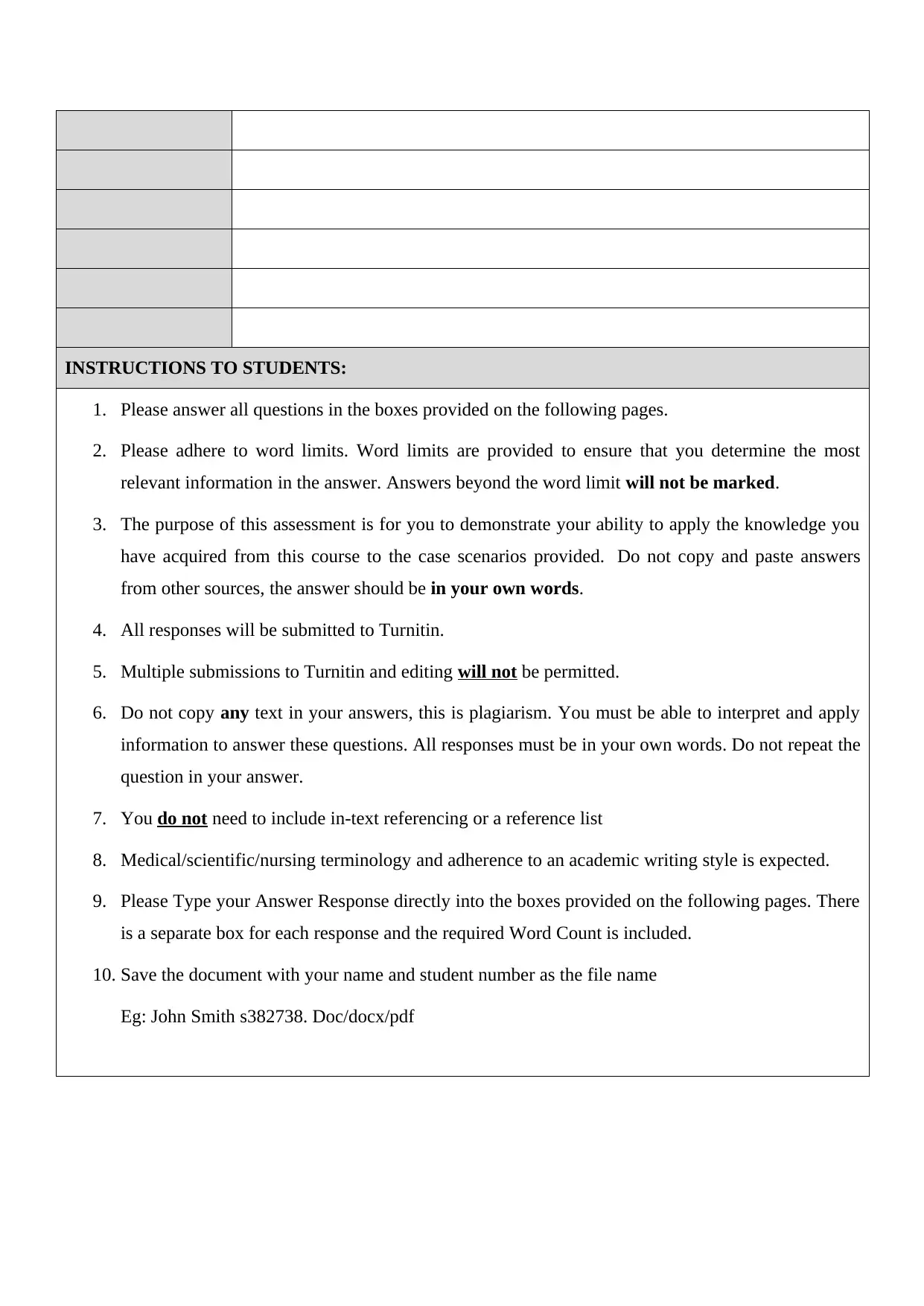
INSTRUCTIONS TO STUDENTS:
1. Please answer all questions in the boxes provided on the following pages.
2. Please adhere to word limits. Word limits are provided to ensure that you determine the most
relevant information in the answer. Answers beyond the word limit will not be marked.
3. The purpose of this assessment is for you to demonstrate your ability to apply the knowledge you
have acquired from this course to the case scenarios provided. Do not copy and paste answers
from other sources, the answer should be in your own words.
4. All responses will be submitted to Turnitin.
5. Multiple submissions to Turnitin and editing will not be permitted.
6. Do not copy any text in your answers, this is plagiarism. You must be able to interpret and apply
information to answer these questions. All responses must be in your own words. Do not repeat the
question in your answer.
7. You do not need to include in-text referencing or a reference list
8. Medical/scientific/nursing terminology and adherence to an academic writing style is expected.
9. Please Type your Answer Response directly into the boxes provided on the following pages. There
is a separate box for each response and the required Word Count is included.
10. Save the document with your name and student number as the file name
Eg: John Smith s382738. Doc/docx/pdf
1. Please answer all questions in the boxes provided on the following pages.
2. Please adhere to word limits. Word limits are provided to ensure that you determine the most
relevant information in the answer. Answers beyond the word limit will not be marked.
3. The purpose of this assessment is for you to demonstrate your ability to apply the knowledge you
have acquired from this course to the case scenarios provided. Do not copy and paste answers
from other sources, the answer should be in your own words.
4. All responses will be submitted to Turnitin.
5. Multiple submissions to Turnitin and editing will not be permitted.
6. Do not copy any text in your answers, this is plagiarism. You must be able to interpret and apply
information to answer these questions. All responses must be in your own words. Do not repeat the
question in your answer.
7. You do not need to include in-text referencing or a reference list
8. Medical/scientific/nursing terminology and adherence to an academic writing style is expected.
9. Please Type your Answer Response directly into the boxes provided on the following pages. There
is a separate box for each response and the required Word Count is included.
10. Save the document with your name and student number as the file name
Eg: John Smith s382738. Doc/docx/pdf
Paraphrase This Document
Need a fresh take? Get an instant paraphrase of this document with our AI Paraphraser
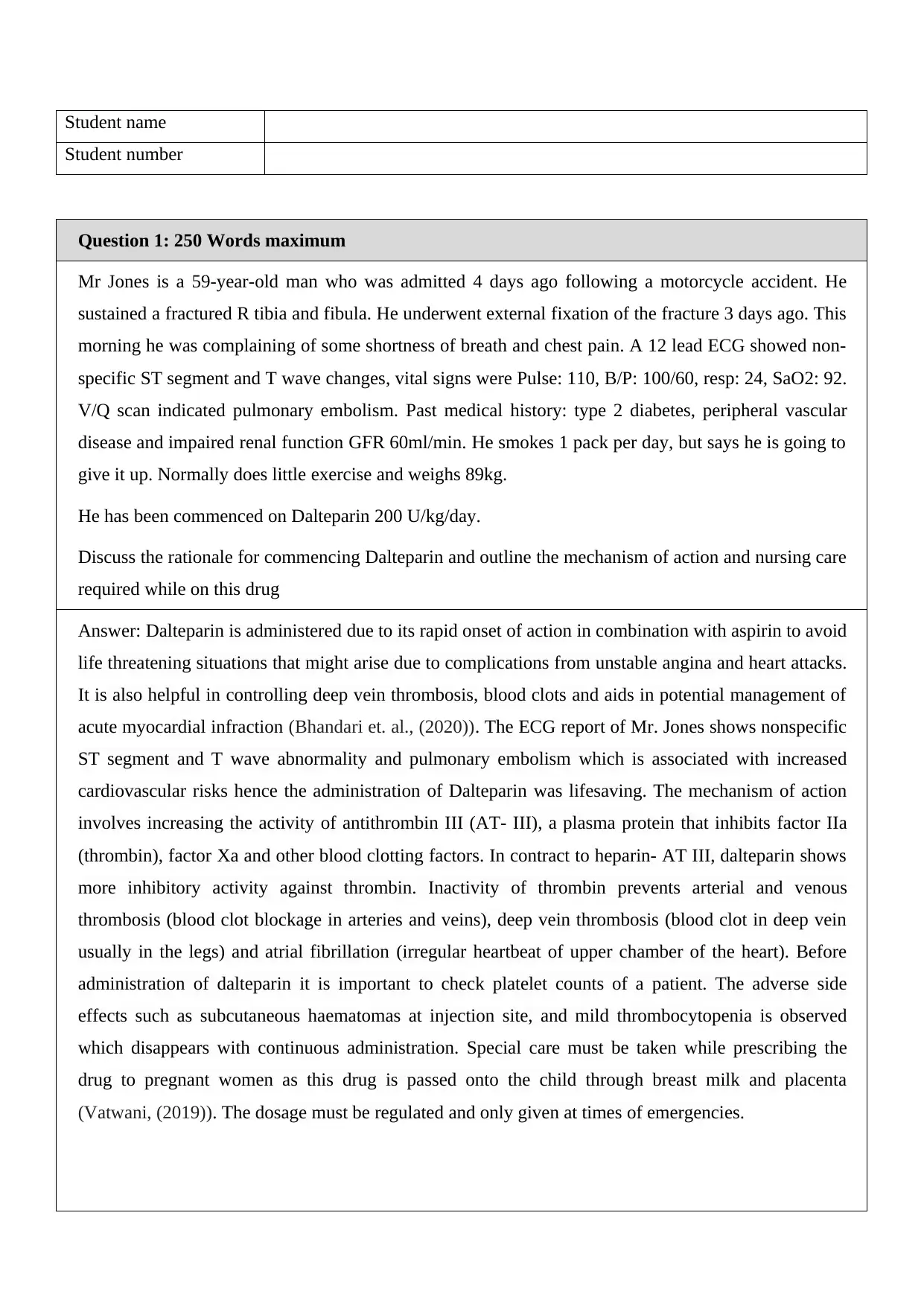
Student name
Student number
Question 1: 250 Words maximum
Mr Jones is a 59-year-old man who was admitted 4 days ago following a motorcycle accident. He
sustained a fractured R tibia and fibula. He underwent external fixation of the fracture 3 days ago. This
morning he was complaining of some shortness of breath and chest pain. A 12 lead ECG showed non-
specific ST segment and T wave changes, vital signs were Pulse: 110, B/P: 100/60, resp: 24, SaO2: 92.
V/Q scan indicated pulmonary embolism. Past medical history: type 2 diabetes, peripheral vascular
disease and impaired renal function GFR 60ml/min. He smokes 1 pack per day, but says he is going to
give it up. Normally does little exercise and weighs 89kg.
He has been commenced on Dalteparin 200 U/kg/day.
Discuss the rationale for commencing Dalteparin and outline the mechanism of action and nursing care
required while on this drug
Answer: Dalteparin is administered due to its rapid onset of action in combination with aspirin to avoid
life threatening situations that might arise due to complications from unstable angina and heart attacks.
It is also helpful in controlling deep vein thrombosis, blood clots and aids in potential management of
acute myocardial infraction (Bhandari et. al., (2020)). The ECG report of Mr. Jones shows nonspecific
ST segment and T wave abnormality and pulmonary embolism which is associated with increased
cardiovascular risks hence the administration of Dalteparin was lifesaving. The mechanism of action
involves increasing the activity of antithrombin III (AT- III), a plasma protein that inhibits factor IIa
(thrombin), factor Xa and other blood clotting factors. In contract to heparin- AT III, dalteparin shows
more inhibitory activity against thrombin. Inactivity of thrombin prevents arterial and venous
thrombosis (blood clot blockage in arteries and veins), deep vein thrombosis (blood clot in deep vein
usually in the legs) and atrial fibrillation (irregular heartbeat of upper chamber of the heart). Before
administration of dalteparin it is important to check platelet counts of a patient. The adverse side
effects such as subcutaneous haematomas at injection site, and mild thrombocytopenia is observed
which disappears with continuous administration. Special care must be taken while prescribing the
drug to pregnant women as this drug is passed onto the child through breast milk and placenta
(Vatwani, (2019)). The dosage must be regulated and only given at times of emergencies.
Student number
Question 1: 250 Words maximum
Mr Jones is a 59-year-old man who was admitted 4 days ago following a motorcycle accident. He
sustained a fractured R tibia and fibula. He underwent external fixation of the fracture 3 days ago. This
morning he was complaining of some shortness of breath and chest pain. A 12 lead ECG showed non-
specific ST segment and T wave changes, vital signs were Pulse: 110, B/P: 100/60, resp: 24, SaO2: 92.
V/Q scan indicated pulmonary embolism. Past medical history: type 2 diabetes, peripheral vascular
disease and impaired renal function GFR 60ml/min. He smokes 1 pack per day, but says he is going to
give it up. Normally does little exercise and weighs 89kg.
He has been commenced on Dalteparin 200 U/kg/day.
Discuss the rationale for commencing Dalteparin and outline the mechanism of action and nursing care
required while on this drug
Answer: Dalteparin is administered due to its rapid onset of action in combination with aspirin to avoid
life threatening situations that might arise due to complications from unstable angina and heart attacks.
It is also helpful in controlling deep vein thrombosis, blood clots and aids in potential management of
acute myocardial infraction (Bhandari et. al., (2020)). The ECG report of Mr. Jones shows nonspecific
ST segment and T wave abnormality and pulmonary embolism which is associated with increased
cardiovascular risks hence the administration of Dalteparin was lifesaving. The mechanism of action
involves increasing the activity of antithrombin III (AT- III), a plasma protein that inhibits factor IIa
(thrombin), factor Xa and other blood clotting factors. In contract to heparin- AT III, dalteparin shows
more inhibitory activity against thrombin. Inactivity of thrombin prevents arterial and venous
thrombosis (blood clot blockage in arteries and veins), deep vein thrombosis (blood clot in deep vein
usually in the legs) and atrial fibrillation (irregular heartbeat of upper chamber of the heart). Before
administration of dalteparin it is important to check platelet counts of a patient. The adverse side
effects such as subcutaneous haematomas at injection site, and mild thrombocytopenia is observed
which disappears with continuous administration. Special care must be taken while prescribing the
drug to pregnant women as this drug is passed onto the child through breast milk and placenta
(Vatwani, (2019)). The dosage must be regulated and only given at times of emergencies.
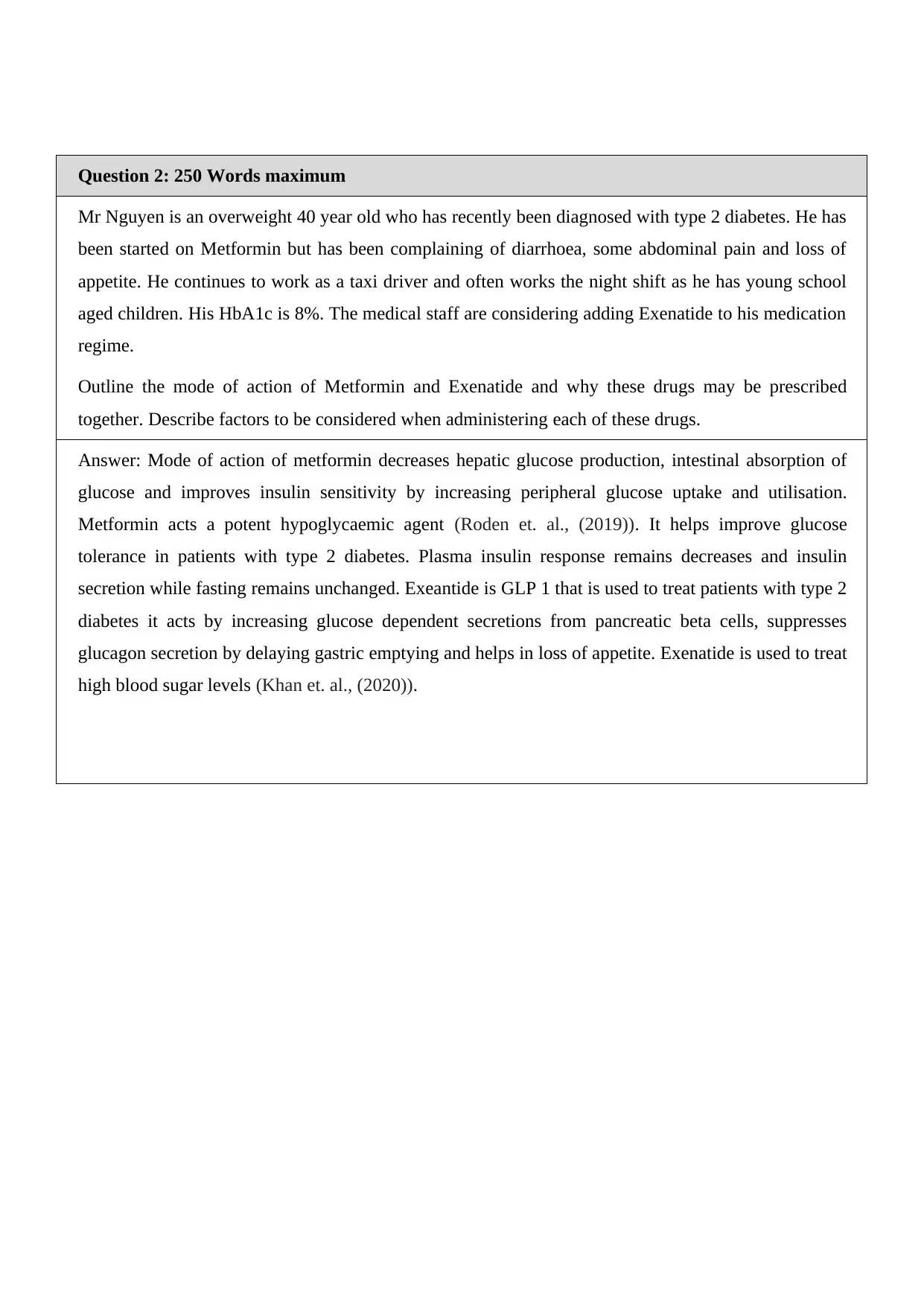
Question 2: 250 Words maximum
Mr Nguyen is an overweight 40 year old who has recently been diagnosed with type 2 diabetes. He has
been started on Metformin but has been complaining of diarrhoea, some abdominal pain and loss of
appetite. He continues to work as a taxi driver and often works the night shift as he has young school
aged children. His HbA1c is 8%. The medical staff are considering adding Exenatide to his medication
regime.
Outline the mode of action of Metformin and Exenatide and why these drugs may be prescribed
together. Describe factors to be considered when administering each of these drugs.
Answer: Mode of action of metformin decreases hepatic glucose production, intestinal absorption of
glucose and improves insulin sensitivity by increasing peripheral glucose uptake and utilisation.
Metformin acts a potent hypoglycaemic agent (Roden et. al., (2019)). It helps improve glucose
tolerance in patients with type 2 diabetes. Plasma insulin response remains decreases and insulin
secretion while fasting remains unchanged. Exeantide is GLP 1 that is used to treat patients with type 2
diabetes it acts by increasing glucose dependent secretions from pancreatic beta cells, suppresses
glucagon secretion by delaying gastric emptying and helps in loss of appetite. Exenatide is used to treat
high blood sugar levels (Khan et. al., (2020)).
Mr Nguyen is an overweight 40 year old who has recently been diagnosed with type 2 diabetes. He has
been started on Metformin but has been complaining of diarrhoea, some abdominal pain and loss of
appetite. He continues to work as a taxi driver and often works the night shift as he has young school
aged children. His HbA1c is 8%. The medical staff are considering adding Exenatide to his medication
regime.
Outline the mode of action of Metformin and Exenatide and why these drugs may be prescribed
together. Describe factors to be considered when administering each of these drugs.
Answer: Mode of action of metformin decreases hepatic glucose production, intestinal absorption of
glucose and improves insulin sensitivity by increasing peripheral glucose uptake and utilisation.
Metformin acts a potent hypoglycaemic agent (Roden et. al., (2019)). It helps improve glucose
tolerance in patients with type 2 diabetes. Plasma insulin response remains decreases and insulin
secretion while fasting remains unchanged. Exeantide is GLP 1 that is used to treat patients with type 2
diabetes it acts by increasing glucose dependent secretions from pancreatic beta cells, suppresses
glucagon secretion by delaying gastric emptying and helps in loss of appetite. Exenatide is used to treat
high blood sugar levels (Khan et. al., (2020)).
⊘ This is a preview!⊘
Do you want full access?
Subscribe today to unlock all pages.

Trusted by 1+ million students worldwide
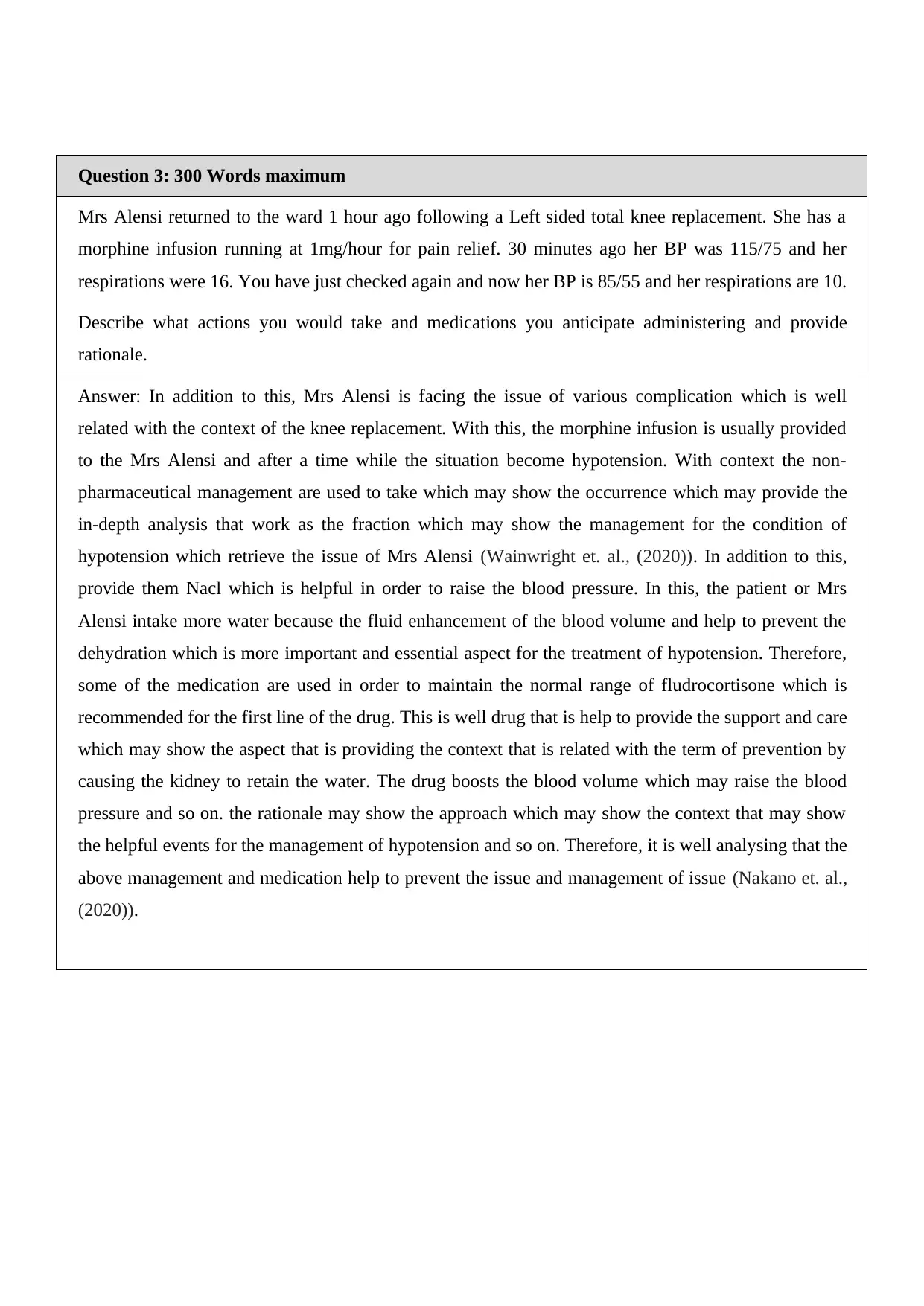
Question 3: 300 Words maximum
Mrs Alensi returned to the ward 1 hour ago following a Left sided total knee replacement. She has a
morphine infusion running at 1mg/hour for pain relief. 30 minutes ago her BP was 115/75 and her
respirations were 16. You have just checked again and now her BP is 85/55 and her respirations are 10.
Describe what actions you would take and medications you anticipate administering and provide
rationale.
Answer: In addition to this, Mrs Alensi is facing the issue of various complication which is well
related with the context of the knee replacement. With this, the morphine infusion is usually provided
to the Mrs Alensi and after a time while the situation become hypotension. With context the non-
pharmaceutical management are used to take which may show the occurrence which may provide the
in-depth analysis that work as the fraction which may show the management for the condition of
hypotension which retrieve the issue of Mrs Alensi (Wainwright et. al., (2020)). In addition to this,
provide them Nacl which is helpful in order to raise the blood pressure. In this, the patient or Mrs
Alensi intake more water because the fluid enhancement of the blood volume and help to prevent the
dehydration which is more important and essential aspect for the treatment of hypotension. Therefore,
some of the medication are used in order to maintain the normal range of fludrocortisone which is
recommended for the first line of the drug. This is well drug that is help to provide the support and care
which may show the aspect that is providing the context that is related with the term of prevention by
causing the kidney to retain the water. The drug boosts the blood volume which may raise the blood
pressure and so on. the rationale may show the approach which may show the context that may show
the helpful events for the management of hypotension and so on. Therefore, it is well analysing that the
above management and medication help to prevent the issue and management of issue (Nakano et. al.,
(2020)).
Mrs Alensi returned to the ward 1 hour ago following a Left sided total knee replacement. She has a
morphine infusion running at 1mg/hour for pain relief. 30 minutes ago her BP was 115/75 and her
respirations were 16. You have just checked again and now her BP is 85/55 and her respirations are 10.
Describe what actions you would take and medications you anticipate administering and provide
rationale.
Answer: In addition to this, Mrs Alensi is facing the issue of various complication which is well
related with the context of the knee replacement. With this, the morphine infusion is usually provided
to the Mrs Alensi and after a time while the situation become hypotension. With context the non-
pharmaceutical management are used to take which may show the occurrence which may provide the
in-depth analysis that work as the fraction which may show the management for the condition of
hypotension which retrieve the issue of Mrs Alensi (Wainwright et. al., (2020)). In addition to this,
provide them Nacl which is helpful in order to raise the blood pressure. In this, the patient or Mrs
Alensi intake more water because the fluid enhancement of the blood volume and help to prevent the
dehydration which is more important and essential aspect for the treatment of hypotension. Therefore,
some of the medication are used in order to maintain the normal range of fludrocortisone which is
recommended for the first line of the drug. This is well drug that is help to provide the support and care
which may show the aspect that is providing the context that is related with the term of prevention by
causing the kidney to retain the water. The drug boosts the blood volume which may raise the blood
pressure and so on. the rationale may show the approach which may show the context that may show
the helpful events for the management of hypotension and so on. Therefore, it is well analysing that the
above management and medication help to prevent the issue and management of issue (Nakano et. al.,
(2020)).
Paraphrase This Document
Need a fresh take? Get an instant paraphrase of this document with our AI Paraphraser
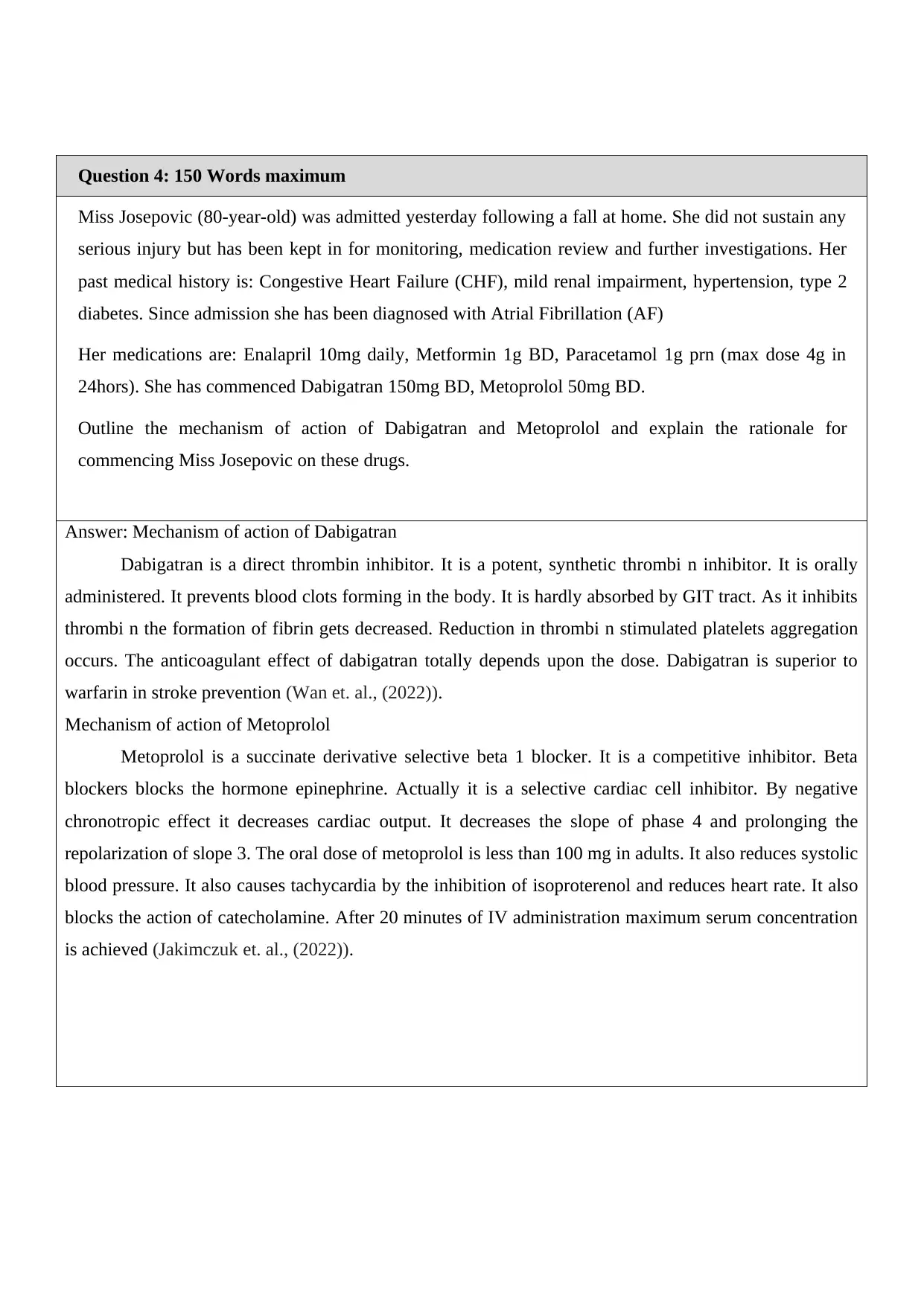
Question 4: 150 Words maximum
Miss Josepovic (80-year-old) was admitted yesterday following a fall at home. She did not sustain any
serious injury but has been kept in for monitoring, medication review and further investigations. Her
past medical history is: Congestive Heart Failure (CHF), mild renal impairment, hypertension, type 2
diabetes. Since admission she has been diagnosed with Atrial Fibrillation (AF)
Her medications are: Enalapril 10mg daily, Metformin 1g BD, Paracetamol 1g prn (max dose 4g in
24hors). She has commenced Dabigatran 150mg BD, Metoprolol 50mg BD.
Outline the mechanism of action of Dabigatran and Metoprolol and explain the rationale for
commencing Miss Josepovic on these drugs.
Answer: Mechanism of action of Dabigatran
Dabigatran is a direct thrombin inhibitor. It is a potent, synthetic thrombi n inhibitor. It is orally
administered. It prevents blood clots forming in the body. It is hardly absorbed by GIT tract. As it inhibits
thrombi n the formation of fibrin gets decreased. Reduction in thrombi n stimulated platelets aggregation
occurs. The anticoagulant effect of dabigatran totally depends upon the dose. Dabigatran is superior to
warfarin in stroke prevention (Wan et. al., (2022)).
Mechanism of action of Metoprolol
Metoprolol is a succinate derivative selective beta 1 blocker. It is a competitive inhibitor. Beta
blockers blocks the hormone epinephrine. Actually it is a selective cardiac cell inhibitor. By negative
chronotropic effect it decreases cardiac output. It decreases the slope of phase 4 and prolonging the
repolarization of slope 3. The oral dose of metoprolol is less than 100 mg in adults. It also reduces systolic
blood pressure. It also causes tachycardia by the inhibition of isoproterenol and reduces heart rate. It also
blocks the action of catecholamine. After 20 minutes of IV administration maximum serum concentration
is achieved (Jakimczuk et. al., (2022)).
Miss Josepovic (80-year-old) was admitted yesterday following a fall at home. She did not sustain any
serious injury but has been kept in for monitoring, medication review and further investigations. Her
past medical history is: Congestive Heart Failure (CHF), mild renal impairment, hypertension, type 2
diabetes. Since admission she has been diagnosed with Atrial Fibrillation (AF)
Her medications are: Enalapril 10mg daily, Metformin 1g BD, Paracetamol 1g prn (max dose 4g in
24hors). She has commenced Dabigatran 150mg BD, Metoprolol 50mg BD.
Outline the mechanism of action of Dabigatran and Metoprolol and explain the rationale for
commencing Miss Josepovic on these drugs.
Answer: Mechanism of action of Dabigatran
Dabigatran is a direct thrombin inhibitor. It is a potent, synthetic thrombi n inhibitor. It is orally
administered. It prevents blood clots forming in the body. It is hardly absorbed by GIT tract. As it inhibits
thrombi n the formation of fibrin gets decreased. Reduction in thrombi n stimulated platelets aggregation
occurs. The anticoagulant effect of dabigatran totally depends upon the dose. Dabigatran is superior to
warfarin in stroke prevention (Wan et. al., (2022)).
Mechanism of action of Metoprolol
Metoprolol is a succinate derivative selective beta 1 blocker. It is a competitive inhibitor. Beta
blockers blocks the hormone epinephrine. Actually it is a selective cardiac cell inhibitor. By negative
chronotropic effect it decreases cardiac output. It decreases the slope of phase 4 and prolonging the
repolarization of slope 3. The oral dose of metoprolol is less than 100 mg in adults. It also reduces systolic
blood pressure. It also causes tachycardia by the inhibition of isoproterenol and reduces heart rate. It also
blocks the action of catecholamine. After 20 minutes of IV administration maximum serum concentration
is achieved (Jakimczuk et. al., (2022)).
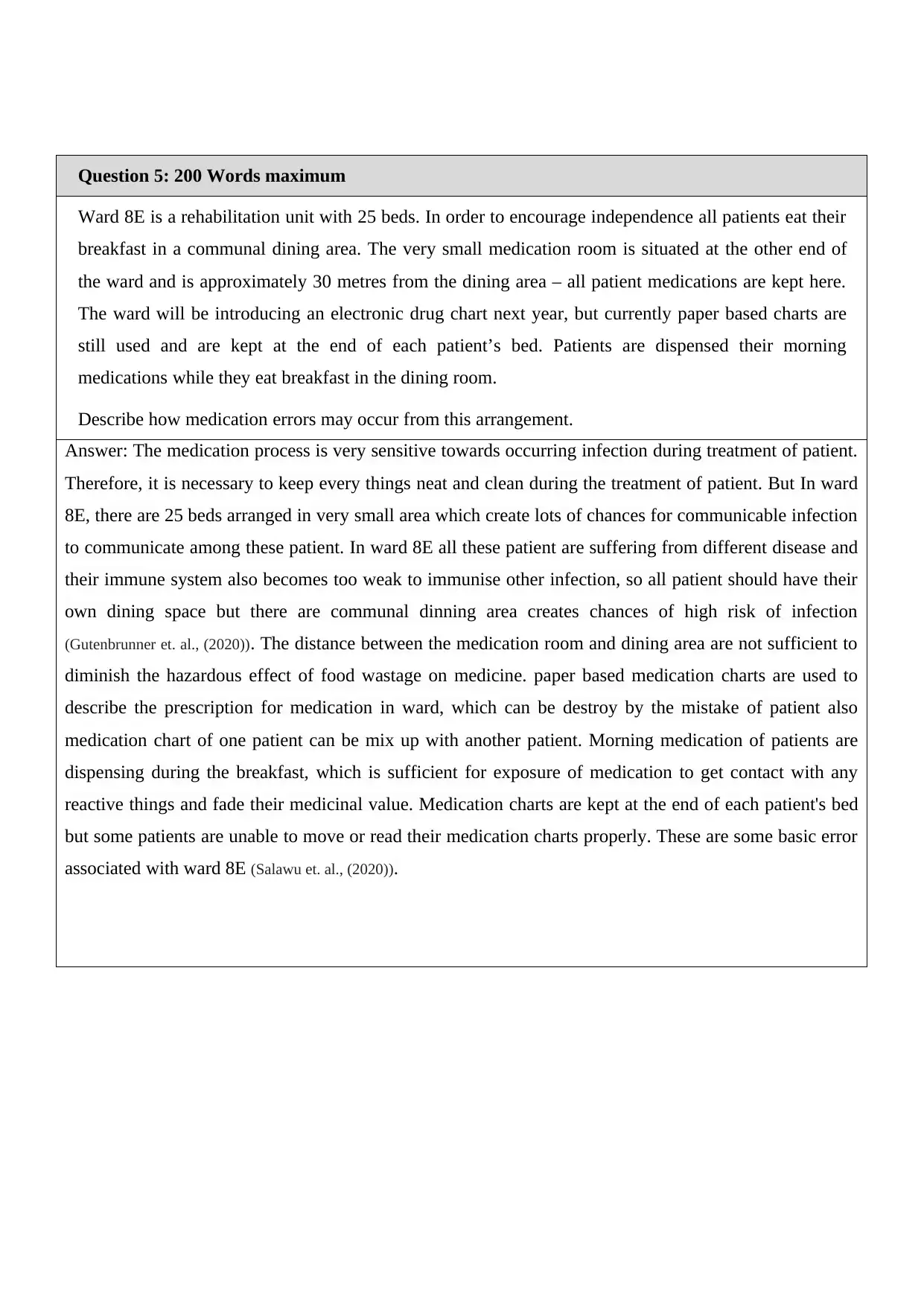
Question 5: 200 Words maximum
Ward 8E is a rehabilitation unit with 25 beds. In order to encourage independence all patients eat their
breakfast in a communal dining area. The very small medication room is situated at the other end of
the ward and is approximately 30 metres from the dining area – all patient medications are kept here.
The ward will be introducing an electronic drug chart next year, but currently paper based charts are
still used and are kept at the end of each patient’s bed. Patients are dispensed their morning
medications while they eat breakfast in the dining room.
Describe how medication errors may occur from this arrangement.
Answer: The medication process is very sensitive towards occurring infection during treatment of patient.
Therefore, it is necessary to keep every things neat and clean during the treatment of patient. But In ward
8E, there are 25 beds arranged in very small area which create lots of chances for communicable infection
to communicate among these patient. In ward 8E all these patient are suffering from different disease and
their immune system also becomes too weak to immunise other infection, so all patient should have their
own dining space but there are communal dinning area creates chances of high risk of infection
(Gutenbrunner et. al., (2020)). The distance between the medication room and dining area are not sufficient to
diminish the hazardous effect of food wastage on medicine. paper based medication charts are used to
describe the prescription for medication in ward, which can be destroy by the mistake of patient also
medication chart of one patient can be mix up with another patient. Morning medication of patients are
dispensing during the breakfast, which is sufficient for exposure of medication to get contact with any
reactive things and fade their medicinal value. Medication charts are kept at the end of each patient's bed
but some patients are unable to move or read their medication charts properly. These are some basic error
associated with ward 8E (Salawu et. al., (2020)).
Ward 8E is a rehabilitation unit with 25 beds. In order to encourage independence all patients eat their
breakfast in a communal dining area. The very small medication room is situated at the other end of
the ward and is approximately 30 metres from the dining area – all patient medications are kept here.
The ward will be introducing an electronic drug chart next year, but currently paper based charts are
still used and are kept at the end of each patient’s bed. Patients are dispensed their morning
medications while they eat breakfast in the dining room.
Describe how medication errors may occur from this arrangement.
Answer: The medication process is very sensitive towards occurring infection during treatment of patient.
Therefore, it is necessary to keep every things neat and clean during the treatment of patient. But In ward
8E, there are 25 beds arranged in very small area which create lots of chances for communicable infection
to communicate among these patient. In ward 8E all these patient are suffering from different disease and
their immune system also becomes too weak to immunise other infection, so all patient should have their
own dining space but there are communal dinning area creates chances of high risk of infection
(Gutenbrunner et. al., (2020)). The distance between the medication room and dining area are not sufficient to
diminish the hazardous effect of food wastage on medicine. paper based medication charts are used to
describe the prescription for medication in ward, which can be destroy by the mistake of patient also
medication chart of one patient can be mix up with another patient. Morning medication of patients are
dispensing during the breakfast, which is sufficient for exposure of medication to get contact with any
reactive things and fade their medicinal value. Medication charts are kept at the end of each patient's bed
but some patients are unable to move or read their medication charts properly. These are some basic error
associated with ward 8E (Salawu et. al., (2020)).
⊘ This is a preview!⊘
Do you want full access?
Subscribe today to unlock all pages.

Trusted by 1+ million students worldwide

REFERENCES
Books and Journals
Bhandari, S., Rankawat, G., Bagarhatta, M., Singh, A., Gupta, V., Sharma, S., & Sharma, R. (2020). Clinico-Radiological
Evaluation and Correlation of CT Chest Images with Progress of Disease in COVID-19 Patients. The journal of the
association of physicians of india, 68(7), 34-42.
Gutenbrunner, C., Stokes, E. K., Dreinhöfer, K., Monsbakken, J., Clarke, S., Côté, P., ... & Nugraha, B. (2020). Why
Rehabilitation must have priority during and after the COVID-19-pandemic: A position statement of the Global
Rehabilitation Alliance. Journal of rehabilitation medicine.
Jakimczuk, A., Kalaska, B., Kamiński, K., Miklosz, J., Yusa, S. I., Pawlak, D., ... & Mogielnicki, A. (2022). Monitoring of
Anticoagulant Activity of Dabigatran and Rivaroxaban in the Presence of Heparins. Journal of clinical medicine, 11(8),
2236.
Khan, M. A. B., Hashim, M. J., King, J. K., Govender, R. D., Mustafa, H., & Al Kaabi, J. (2020). Epidemiology of type 2
diabetes–global burden of disease and forecasted trends. Journal of epidemiology and global health, 10(1), 107.
Nakano, N., Shoman, H., Olavarria, F., Matsumoto, T., Kuroda, R., & Khanduja, V. (2020). Why are patients dissatisfied
following a total knee replacement? A systematic review. International orthopaedics, 44(10), 1971-2007.
Roden, M., & Shulman, G. I. (2019). The integrative biology of type 2 diabetes. Nature, 576(7785), 51-60.
Salawu, A., Green, A., Crooks, M. G., Brixey, N., Ross, D. H., & Sivan, M. (2020). A proposal for multidisciplinary tele-
rehabilitation in the assessment and rehabilitation of COVID-19 survivors. International journal of environmental
research and public health, 17(13), 4890.
Vatwani, A. (2019). Pursed lip breathing exercise to reduce shortness of breath. Archives of physical medicine and
rehabilitation, 100(1), 189-190.
Wainwright, T. W., Gill, M., McDonald, D. A., Middleton, R. G., Reed, M., Sahota, O., ... & Ljungqvist, O. (2020). Consensus
statement for perioperative care in total hip replacement and total knee replacement surgery: Enhanced Recovery After
Surgery (ERAS®) Society recommendations. Acta orthopaedica, 91(1), 3-19.
Wan, S., Cui, S., Jiang, M., Wu, Q., Ji, Y., Xu, Y., & Gong, G. (2022). Dual‐target synergistic antithrombotic mechanism of a
dabigatran etexilate analogue (HY023016). Clinical and Experimental Pharmacology and Physiology, 49(5), 567-576.
THIS COMPLETES YOUR ASSESSMENT TASK.
Books and Journals
Bhandari, S., Rankawat, G., Bagarhatta, M., Singh, A., Gupta, V., Sharma, S., & Sharma, R. (2020). Clinico-Radiological
Evaluation and Correlation of CT Chest Images with Progress of Disease in COVID-19 Patients. The journal of the
association of physicians of india, 68(7), 34-42.
Gutenbrunner, C., Stokes, E. K., Dreinhöfer, K., Monsbakken, J., Clarke, S., Côté, P., ... & Nugraha, B. (2020). Why
Rehabilitation must have priority during and after the COVID-19-pandemic: A position statement of the Global
Rehabilitation Alliance. Journal of rehabilitation medicine.
Jakimczuk, A., Kalaska, B., Kamiński, K., Miklosz, J., Yusa, S. I., Pawlak, D., ... & Mogielnicki, A. (2022). Monitoring of
Anticoagulant Activity of Dabigatran and Rivaroxaban in the Presence of Heparins. Journal of clinical medicine, 11(8),
2236.
Khan, M. A. B., Hashim, M. J., King, J. K., Govender, R. D., Mustafa, H., & Al Kaabi, J. (2020). Epidemiology of type 2
diabetes–global burden of disease and forecasted trends. Journal of epidemiology and global health, 10(1), 107.
Nakano, N., Shoman, H., Olavarria, F., Matsumoto, T., Kuroda, R., & Khanduja, V. (2020). Why are patients dissatisfied
following a total knee replacement? A systematic review. International orthopaedics, 44(10), 1971-2007.
Roden, M., & Shulman, G. I. (2019). The integrative biology of type 2 diabetes. Nature, 576(7785), 51-60.
Salawu, A., Green, A., Crooks, M. G., Brixey, N., Ross, D. H., & Sivan, M. (2020). A proposal for multidisciplinary tele-
rehabilitation in the assessment and rehabilitation of COVID-19 survivors. International journal of environmental
research and public health, 17(13), 4890.
Vatwani, A. (2019). Pursed lip breathing exercise to reduce shortness of breath. Archives of physical medicine and
rehabilitation, 100(1), 189-190.
Wainwright, T. W., Gill, M., McDonald, D. A., Middleton, R. G., Reed, M., Sahota, O., ... & Ljungqvist, O. (2020). Consensus
statement for perioperative care in total hip replacement and total knee replacement surgery: Enhanced Recovery After
Surgery (ERAS®) Society recommendations. Acta orthopaedica, 91(1), 3-19.
Wan, S., Cui, S., Jiang, M., Wu, Q., Ji, Y., Xu, Y., & Gong, G. (2022). Dual‐target synergistic antithrombotic mechanism of a
dabigatran etexilate analogue (HY023016). Clinical and Experimental Pharmacology and Physiology, 49(5), 567-576.
THIS COMPLETES YOUR ASSESSMENT TASK.
Paraphrase This Document
Need a fresh take? Get an instant paraphrase of this document with our AI Paraphraser
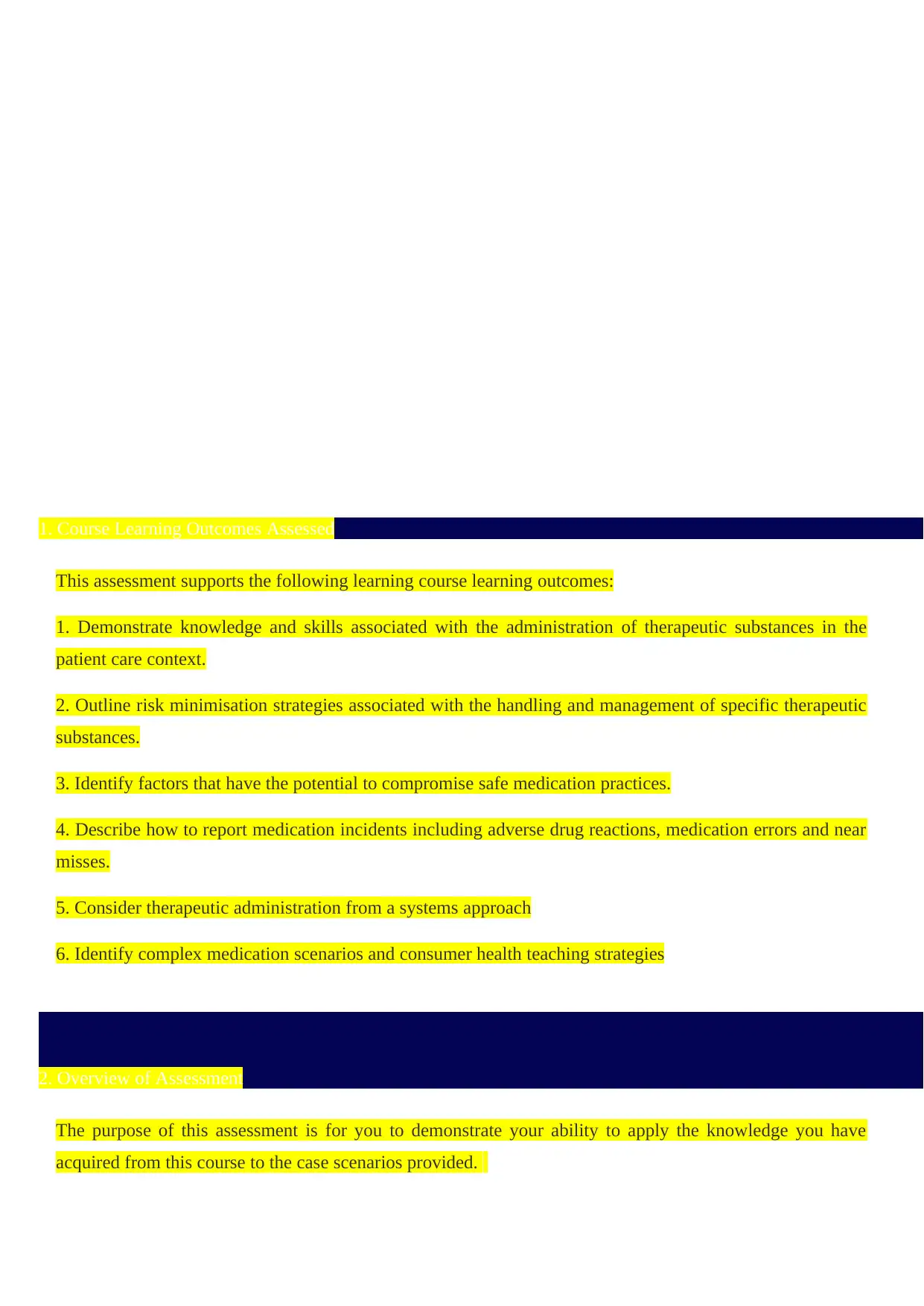
1. Course Learning Outcomes Assessed
This assessment supports the following learning course learning outcomes:
1. Demonstrate knowledge and skills associated with the administration of therapeutic substances in the
patient care context.
2. Outline risk minimisation strategies associated with the handling and management of specific therapeutic
substances.
3. Identify factors that have the potential to compromise safe medication practices.
4. Describe how to report medication incidents including adverse drug reactions, medication errors and near
misses.
5. Consider therapeutic administration from a systems approach
6. Identify complex medication scenarios and consumer health teaching strategies
2. Overview of Assessment
The purpose of this assessment is for you to demonstrate your ability to apply the knowledge you have
acquired from this course to the case scenarios provided.
This assessment supports the following learning course learning outcomes:
1. Demonstrate knowledge and skills associated with the administration of therapeutic substances in the
patient care context.
2. Outline risk minimisation strategies associated with the handling and management of specific therapeutic
substances.
3. Identify factors that have the potential to compromise safe medication practices.
4. Describe how to report medication incidents including adverse drug reactions, medication errors and near
misses.
5. Consider therapeutic administration from a systems approach
6. Identify complex medication scenarios and consumer health teaching strategies
2. Overview of Assessment
The purpose of this assessment is for you to demonstrate your ability to apply the knowledge you have
acquired from this course to the case scenarios provided.
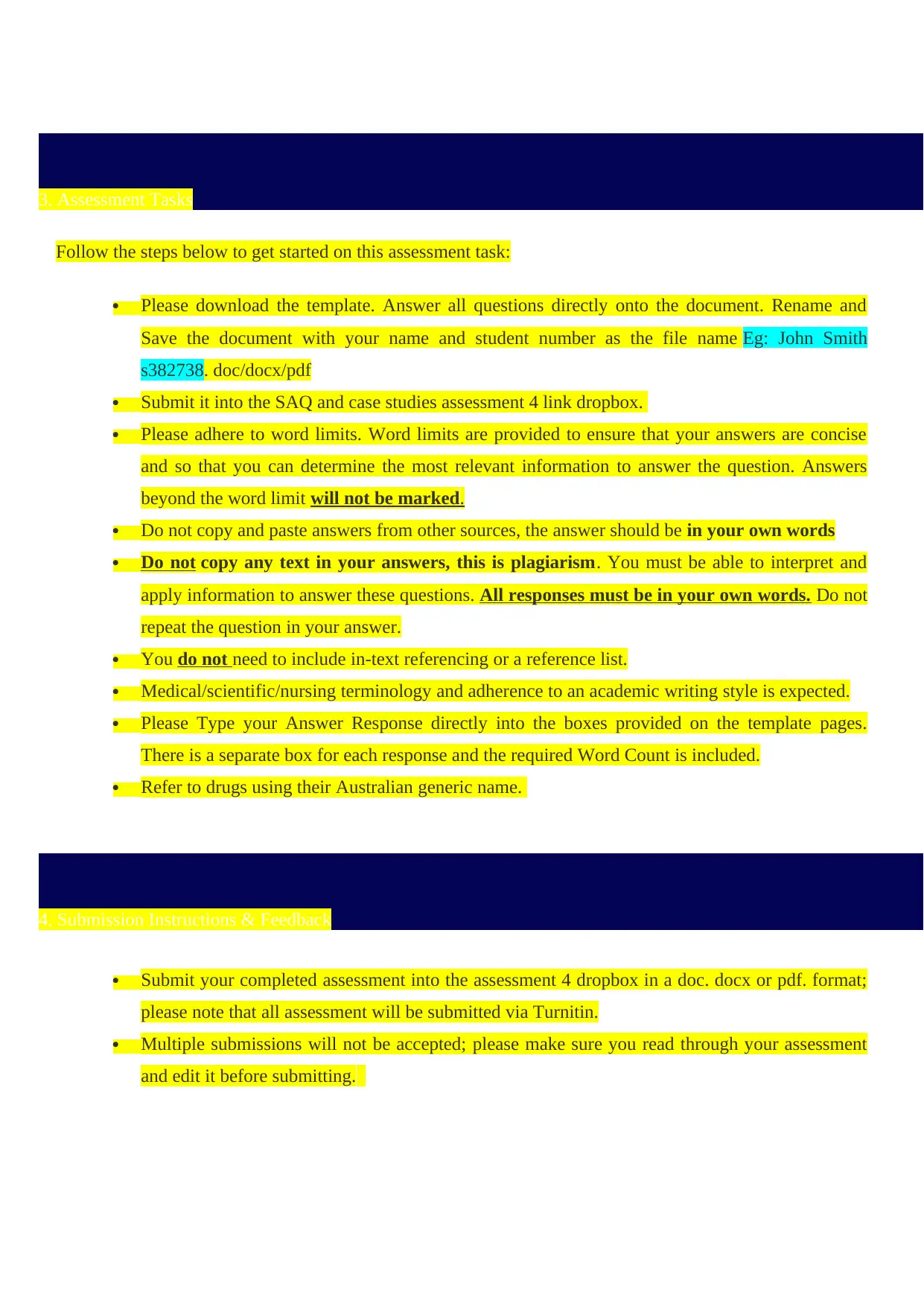
3. Assessment Tasks
Follow the steps below to get started on this assessment task:
Please download the template. Answer all questions directly onto the document. Rename and
Save the document with your name and student number as the file name Eg: John Smith
s382738. doc/docx/pdf
Submit it into the SAQ and case studies assessment 4 link dropbox.
Please adhere to word limits. Word limits are provided to ensure that your answers are concise
and so that you can determine the most relevant information to answer the question. Answers
beyond the word limit will not be marked.
Do not copy and paste answers from other sources, the answer should be in your own words
Do not copy any text in your answers, this is plagiarism. You must be able to interpret and
apply information to answer these questions. All responses must be in your own words. Do not
repeat the question in your answer.
You do not need to include in-text referencing or a reference list.
Medical/scientific/nursing terminology and adherence to an academic writing style is expected.
Please Type your Answer Response directly into the boxes provided on the template pages.
There is a separate box for each response and the required Word Count is included.
Refer to drugs using their Australian generic name.
4. Submission Instructions & Feedback
Submit your completed assessment into the assessment 4 dropbox in a doc. docx or pdf. format;
please note that all assessment will be submitted via Turnitin.
Multiple submissions will not be accepted; please make sure you read through your assessment
and edit it before submitting.
Follow the steps below to get started on this assessment task:
Please download the template. Answer all questions directly onto the document. Rename and
Save the document with your name and student number as the file name Eg: John Smith
s382738. doc/docx/pdf
Submit it into the SAQ and case studies assessment 4 link dropbox.
Please adhere to word limits. Word limits are provided to ensure that your answers are concise
and so that you can determine the most relevant information to answer the question. Answers
beyond the word limit will not be marked.
Do not copy and paste answers from other sources, the answer should be in your own words
Do not copy any text in your answers, this is plagiarism. You must be able to interpret and
apply information to answer these questions. All responses must be in your own words. Do not
repeat the question in your answer.
You do not need to include in-text referencing or a reference list.
Medical/scientific/nursing terminology and adherence to an academic writing style is expected.
Please Type your Answer Response directly into the boxes provided on the template pages.
There is a separate box for each response and the required Word Count is included.
Refer to drugs using their Australian generic name.
4. Submission Instructions & Feedback
Submit your completed assessment into the assessment 4 dropbox in a doc. docx or pdf. format;
please note that all assessment will be submitted via Turnitin.
Multiple submissions will not be accepted; please make sure you read through your assessment
and edit it before submitting.
⊘ This is a preview!⊘
Do you want full access?
Subscribe today to unlock all pages.

Trusted by 1+ million students worldwide
1 out of 9
Your All-in-One AI-Powered Toolkit for Academic Success.
+13062052269
info@desklib.com
Available 24*7 on WhatsApp / Email
![[object Object]](/_next/static/media/star-bottom.7253800d.svg)
Unlock your academic potential
Copyright © 2020–2025 A2Z Services. All Rights Reserved. Developed and managed by ZUCOL.

